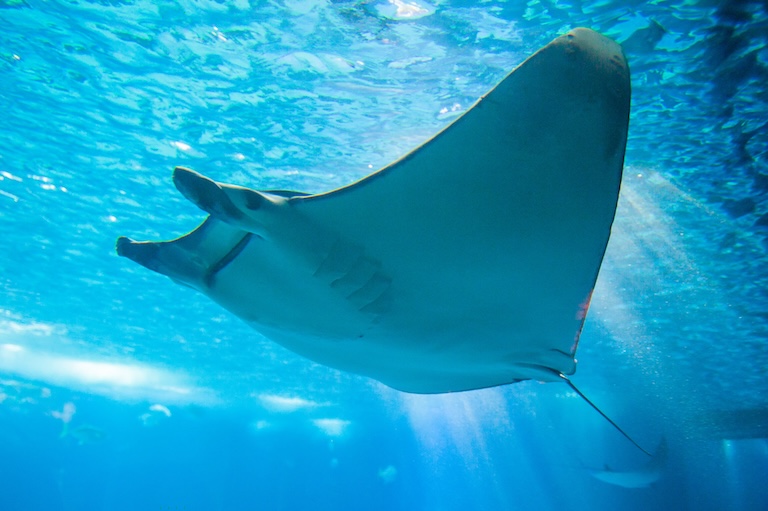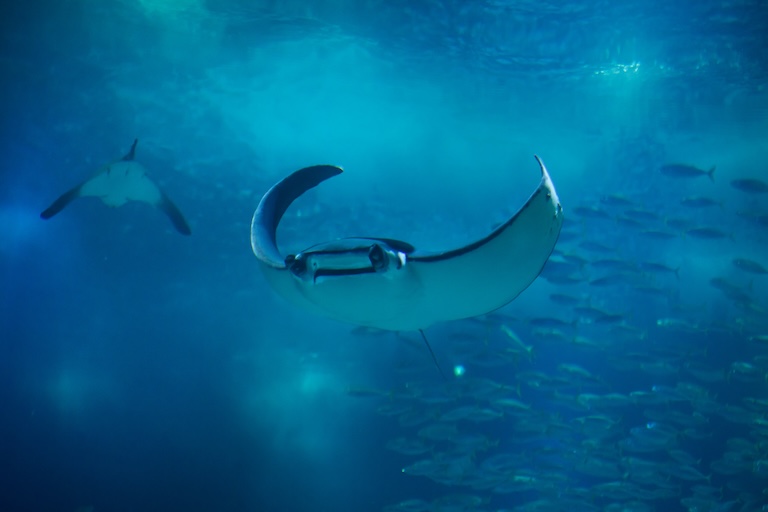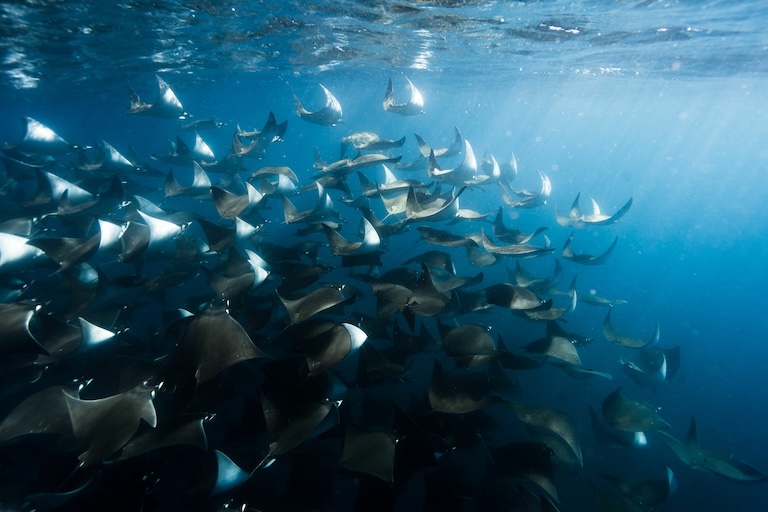Devil Fish Profile
The name “Devil Fish” used to get thrown around with reckless abandon, usually to refer to any animal that wasn’t easy to kill or took a justifiable dislike to human presence in the oceans.
Grey whales were called devil fish because they had the audacity to retaliate to being harpooned in the face.
Octopus were once called devil fish on account of them… being weird? Nobody knows why. It’s also the name given to a species of stone fish that’s rude enough to protect itself from being stepped on.
Another mollusc, the Humboldt squid is perhaps more worthy of the title as a deep-sea tentacled monster that has been known to swarm and attack people (still, not a fish).
But possibly the least deserving is the topic of today’s post: the Giant Devil Ray, a similar creature to the [giant manta], and one of the gentlest and most intelligent creatures in the ocean.

Devil Fish Facts Overview
| Habitat: | Marine, coastal, continental shelf |
| Location: | Mediterranean, Eastern Atlantic, Eastern Pacific |
| Lifespan: | 20 years |
| Size: | 3.5 metres (11 ft) across |
| Weight: | 300kg (661 lb), sometimes more |
| Colour: | Dark/black on top, creamy white underneath |
| Diet: | Plankton and small fish |
| Predators: | Sharks, orca, humans |
| Top Speed: | Unknown |
| No. of Species: | 1 |
| Conservation Status: | Endangered (IUCN) |
Mobula rays are true wonders of nature. They are stunning animals with both grace and power and are known to exhibit remarkable intelligence and inquisitiveness. These animals would not be out of place cruising the oceans of Pandora, and they’d probably be a lot better off. Sadly, this species is now Endangered and in decline like so many others due to overfishing.
But there is hope. Small and achievable changes in the SOPs of the biggest culprits could reverse the trend and see the species make a remarkable recovery.
Interesting Devil Fish Facts
1. They’re angelic
Mobula rays like this one are similar in appearance to the Mantas, both in size and shape. The two genera have a lot in common, and these are smart, curious, and gentle creatures who spend a lot of time on the move.
The Latin name refers to their mobility, and the Devil fish is just one of eleven species in the genus, none of which deserve the name other than the fact that they have a pair of “horns”, sometimes called “cephalic lobes” by people who can’t think of a better term.
2. But horny
These protrusions are interesting because fish of all kinds only have two pairs of appendages along their bodies: the pectoral and anal fins.
But these rays appear to have grown a third, which would be as unusual as a mammal evolving a third pair of limbs.
As it turns out, they’re not distinct from the first set and are a modified lobe of the front fins, which split in the developmental stage and separate between feeding and swimming. 1
3. They can sting
Devil fish rays are only slightly different to look at than Mantas, but they can be told apart by their more slender and pointed ‘wings’ and the way their ‘horns’ are straighter than those of the Manta.
But one of the sharpest contrasts between the Mantas and the Mobulids is the tail spike, which like in stingrays, is present as a protective weapon in Mobula rays, and absent in the Mantas. 2 3
4. They can breach
While Mobulids spend much of their time looking awesome and cruising through the ocean, they’re surprisingly powerful when they want to be.
They’re capable of throwing themselves entirely out of the water, and this is thought to be some way of attracting a mate, or possibly a result of people using Enya for their soundtrack.
5. They occasionally dive
They’re not only adept at rocketing upwards, they can descend, too. Devil fish spend the majority of their time in the surface layers in shallow and continental shelf waters. They’re usually found no deeper than 50 meters but have been recorded diving to as low as 1,100m, perhaps in search of food.
Other gentle elasmobranchs like the whale shark do these deep dives and one hypothesis for it is that they can stay warm down there for a lot longer than their small parasites, so the dives act as a sort of cryo treatment for unwanted tag-alongs.
These rays also take on some pretty epic horizontal migrations, travelling over 60km per day, up to 1,800 km in one trip.
Another fun thing they do is barrel roll! 4
6. Mating trains
Most of what we know about these animals comes from fishing data, so it’s quite limited, but the fact that a vessel can pull up mostly males in a single location suggests huge mating congregations, and there have been some sexual activities spotted by researchers, too.
One such “mating train” was described as a full-term pregnant female with four males, who were apparently involved in a courtship ritual in which the lead male would nuzzle the abdomen of the female as she swam up to the surface. 5 6

7. They’re slow breeders
Gestation is 12 months in this species, which is a very low rate of reproduction, and this is compounded by the fact that usually a single pup is born.
On top of this, it can be 1-3 years before they breed again, making the species very vulnerable to decline.
8. Tuna fisheries are a problem
You’ll have heard of the fallacious phrase “dolphin-friendly tuna”, but even if it were true, it still makes no claim about the countless other species that are affected by the tuna fishing industry in particular.
These rays are extremely vulnerable to tuna and swordfish fishing and are discarded, dead, as bycatch in alarming and unsustainable numbers.
By 1994, the expansion of purse-seine fishing was gulping up everything bigger than a thumb tack, including these gentle elasmobranchs. Almost immediately, the populations in the East Pacific went from “Least Vulnerable” to “Most Vulnerable”.
9. Post-capture mortality might be the key to saving them
The trick to being an effective conservationist is understanding the difference between what is and what should be. This is true in more ways than one, but in particular, it’s important not to let ideals stand in the way of success.
While a total ban on purse-seine fishing and a miraculous shift in global food habits would save the world from ecological collapse without question, there may be a way to reduce the damage more realistically, and understanding how to prevent post-capture mortality in bycatch is one of them.
Researchers ran ecological risk assessments on the impacts to this species of the tuna industry in the East Pacific. They designed 45 hypothetical conservation methods, and 31 of them returned the species to “Least Vulnerable” merely by reducing post-capture mortality by 20%.
That means, if just 20% of the dead rays thrown overboard could instead be rescued, the species should bounce back. And this is most definitely attainable.
Educating fishermen in best handling practices and making these practices cost-effective and easy to pull off is a lot simpler than designing new technology to avoid the problem in the first place.
This of course leaves a lot of other species in the lurch, but it’s a great place to start.

Devil Fish Fact-File Summary
Scientific Classification
| Kingdom: | Animalia |
| Phylum: | Chordata |
| Class: | Chondrichthyes |
| Order: | Myliobatiformes |
| Family: | Mobulidae |
| Genus: | Mobula |
| Species: | mobular |
Fact Sources & References
- Patrick Monahan (2018), “How the devil ray got its horns”, Physorg.
- “WHAT ARE MOBULID RAYS?”, Manta Trust.
- “Species Spotlight: Oceanic Manta Rays vs Spine-Tailed Devil Rays”, Auckland Whale & Dolphin Safari.
- David Maloney (2013), “Devil Rays Jumping”, YouTube.
- Malcolm Francis (2017), “Movement , depth distribution and survival of spinetail devilrays ( Mobula japanica ) tagged and released from purse-seine catches in New Zealand”, Research Gate.
- Mohammed Abudaya (2017), “Speak of the devil ray (Mobula mobular) fishery in Gaza”, Springer Link.
